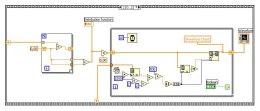Hi,
I guess i am a bit confused..
First of all, let's be sure that you know what i'm looking for: i want
to get values following a dessired distribution function. Is that what
your proposed algorithm makes? if so, where do we have the points?
Analizing your algorithm, this is what i guess it does: from an array
conteining the values of the probability density function, you draw it,
you build the probability distribution function, and then... i get
lost. I guess that what you are trying to do is to build a "simulated"
probability distribution function. Every time you get a number, you add
1 to the equivalent position of a 0 array, so the real probability
distribution function is suposed to be drawn. But i guess it doesn't
work (at least in my laptop with LV7.0). You can find encolosed my
suggestion to do this. Basically, for each number taken from the array
(x), I look for its equivalent position in a 0 array (500 + x*500/2 for
an array of1000 values), and I add 1 in this array. This will be the
"simulated" distribution probability function. What do you think about
it?
Another point, i would like to know what do you think about the way of
generating random points from a normal distribution that I'm using in
secuence 2: if i have an array of 1000 elements that i know they are
following the probability distribution, i just select one value each
iteration using the random generator. Are this values following the
same probability distribution? In case they are, it will be ok for me,
it's what i'm looking for. I know it's not necessary to say this, but
whatever your answer is, i would like you to be sure about it.
Thank you very much to all of you for your time! :-)
untitled1.JPG:
Loading Image...
number generation.JPG:
http://forums.ni.com/attachments/ni/170/242004/2/number generation.JPG
probability density function.JPG:
http://forums.ni.com/attachments/ni/170/242004/3/probability density function.JPG